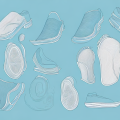Have you ever experienced a nagging pain in your body that just won’t seem to go away? It could be due to trigger points – knots of muscle fibers that can form in our bodies due to stress, poor posture, and injury. Trigger points can be painful, and they can also cause pain to radiate to other areas of the body. If you’re looking for a way to alleviate trigger point pain on your own, using a tennis ball for self-massage can be a highly effective and affordable solution. In this article, we’ll go over everything you need to know about using a tennis ball for trigger point self-massage.
Why Tennis Balls are Effective for Trigger Point Massage
Tennis balls are a simple and inexpensive tool that can be used to massage trigger points. They can help to apply pressure to specific areas of the body with precision, which can help to alleviate pain and tension. Additionally, tennis balls are firm enough to provide the necessary pressure, but also offer some flexibility, making them gentler on the body than other massage tools like foam rollers or lacrosse balls. Because many of us have tennis balls lying around the house, it’s an accessible tool for anyone to use for self-massage.
Understanding Trigger Points and their Effects on the Body
Trigger points can be described as hypersensitive areas within a muscle that can cause pain, tightness, or weakness. They can develop in any muscle in the body and can be exacerbated by a variety of factors, including physical and emotional stress, overuse or strain, and poor posture. Trigger points can also cause referred pain, which means that pain can be felt in areas of the body that are not directly associated with the trigger point itself. For example, a trigger point in the shoulder could cause pain in the neck, chest, or arm.
Benefits of Self-Massage with a Tennis Ball
Self-massage with a tennis ball can bring a variety of benefits to the body. By targeting trigger points, you can alleviate pain and tension, improve flexibility and range of motion, and increase blood flow to the affected area. Additionally, self-massage can help to release endorphins, which are the body’s natural painkillers. This can result in a feeling of overall relaxation and a reduction in stress levels.
Choosing the Right Tennis Ball for Trigger Point Massage
When selecting a tennis ball for self-massage, it’s important to choose one that’s right for your body. If you’re new to self-massage or have a lower pain tolerance, you may want to start with a softer ball. If you’re experienced with trigger point massage and prefer a more intense pressure, a firmer ball may be more appropriate. Additionally, the size of the ball can affect the amount of pressure applied. A larger ball will provide a gentler pressure, while a smaller ball will be more focused and intense.
Preparing Your Body and Environment for Self-Massage
Before beginning any massage, it’s important to prepare your body and environment to ensure safety and comfort. Choose a quiet and private space where you can relax without distraction. Wear loose-fitting clothing that allows for ease of movement, and remove any jewelry or accessories that could interfere with the massage. Take a few deep breaths and try to center your mind before beginning.
Finding Trigger Points and Understanding Pain Patterns
One of the key elements of self-massage with a tennis ball is identifying trigger points and understanding pain patterns. This can take some practice, but with time and patience, you’ll be able to locate and target specific areas of the body that need attention. Look for areas of the body that feel tender or painful to the touch, and play around with the pressure to find what feels most effective for you. It’s important to remember that everyone’s trigger points and pain patterns are unique, so don’t be discouraged if it takes some time to find what works best for your body.
Techniques for Applying Pressure with a Tennis Ball
When using a tennis ball for self-massage, there are several techniques you can use to apply pressure to trigger points. Here are a few to try:-Place the ball between your body and a hard surface, such as a wall, floor, or chair. Use your body weight to apply pressure to the ball, rolling it over the affected area.-Lie on the floor and place the ball under your back or hips. Roll the ball back and forth, using your legs to control the movement and pressure.-Use your hands to hold the ball and apply pressure to specific points on the body, such as the feet or hands.
Adjusting Pressure Based on Comfort and Tolerance
It’s important to remember that everyone’s pain tolerance and trigger points are unique, so adjust the pressure of the ball accordingly. If a particular area is too painful, try using a softer ball or reducing the amount of pressure applied. On the other hand, if you’re not feeling much of an effect, try a firmer ball or increasing the pressure. Listen to your body and adjust as needed to ensure that the massage is effective but not causing unnecessary pain or discomfort.
How Long to Massage Each Trigger Point and When to Stop
When targeting trigger points, it’s important to spend enough time massaging the area to achieve maximum results. However, it’s also important to not overdo it, as too much pressure or time spent on an area could cause additional pain or damage. As a general rule of thumb, aim to massage each area for about 30-60 seconds at a time. If you’re targeting a particularly stubborn trigger point or experiencing significant pain relief, you may choose to extend the massage time slightly. However, if you’re experiencing increased pain or discomfort, stop the massage immediately and seek medical attention if necessary.
Common Mistakes to Avoid During Self-Massage
While self-massage with a tennis ball can be highly effective, there are some common mistakes to avoid to ensure that the massage is safe and beneficial. Here are a few to keep in mind:-Don’t massage over an open wound, bruise, or infection.-Don’t massage directly on the spine or over joints.-Don’t hold your breath during the massage.-Don’t push through excessive pain or discomfort.
Using Heat or Cold Therapy in Conjunction with Self-Massage
Heat or cold therapy can be a helpful addition to self-massage with a tennis ball. Heat can help to relax tense muscles and improve circulation, while cold can help to reduce inflammation and swelling. Before incorporating heat or cold therapy, make sure to consult with a medical professional to determine the best course of treatment for your specific condition.
Safety Precautions to Keep in Mind While Massaging with a Tennis Ball
While self-massage with a tennis ball is generally safe, there are some precautions to keep in mind to ensure that the massage is beneficial and not harmful. Here are a few to consider:-Start with a gentle pressure before gradually increasing to more intense pressure.-Stop the massage if you experience significant pain or discomfort.-Be mindful of any medical conditions that may be affected by self-massage, such as osteoporosis or arthritis.-If you have any concerns about the safety of self-massage, consult with a medical professional before beginning.
Incorporating Regular Self-Massage into Your Wellness Routine
Self-massage with a tennis ball can be a powerful tool for improving overall wellness and reducing pain and tension. To make the most of this technique, consider incorporating it into your daily or weekly routine. Start with just a few minutes of massage per day, and gradually increase the time as you become more comfortable and experienced. With practice and consistency, you may find that trigger point self-massage with a tennis ball becomes an essential part of your wellness routine.
Additional Tools and Techniques to Enhance Trigger Point Massage with a Tennis Ball
While a tennis ball can be a highly effective tool for self-massage, there are also other tools and techniques that can be used to enhance this practice. Foam rollers, massage balls, and massage sticks can all be used to apply pressure to trigger points with varying levels of intensity. Additionally, incorporating relaxation techniques like deep breathing, meditation, or yoga can help to promote overall relaxation and reduce stress levels.
Using a tennis ball for trigger point self-massage can be a simple and affordable way to alleviate pain and tension in your body. By following these tips and techniques, you can make the most of this powerful tool and improve your overall wellness.





